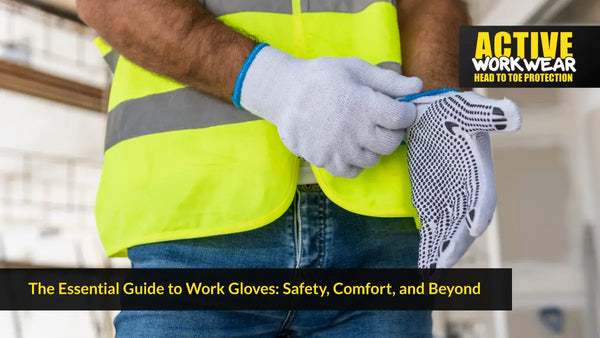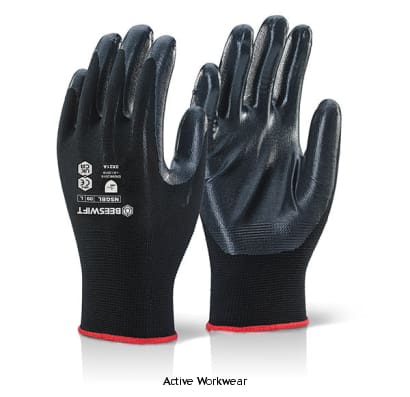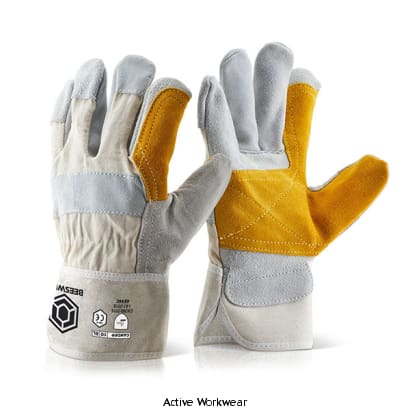The Essential Guide to Work Gloves: Safety, Comfort, and Beyond
- by Mike Johnson

The Essential Guide to Work Gloves: Safety, Comfort, and Beyond
Work gloves are no longer just a rudimentary protective tool; they have evolved into a meticulously engineered product designed to ensure safety, enhance productivity, and provide comfort. Whether your profession involves handling hazardous materials, working in extreme temperatures, or simply requiring a sure grip, there’s a pair of work gloves designed to meet your needs. This comprehensive guide aims to demystify the world of work gloves, helping you choose the best pair for your specific needs.
Unravelling the Evolution of Work Gloves
Work gloves have been around for centuries, with their basic principle remaining unchanged: to protect the user’s hands. However, the materials and technologies employed have significantly evolved over time.
In the early days, work gloves were essentially just simple leather mitts, designed to offer basic protection against rough surfaces and minor hazards. However, with the advancement in technology and materials, work gloves have transformed into sophisticated protective gear that caters to various industry-specific needs.
From cut-resistant and heat-resistant gloves to high-dexterity and touchscreen-compatible varieties, work gloves have become tailored solutions for different tasks. These advancements have not only enhanced the protection offered by work gloves but also improved their comfort and usability.
The Impact of Regulatory Development
Over the years, occupational safety and health regulations have become more stringent, necessitating the use of appropriate personal protective equipment (PPE), including work gloves. Workers and employers alike now recognise the crucial role that gloves play in preventing injuries and reducing the risk of workplace accidents.
How to Choose the Right Work Gloves: Material Matters
When choosing work gloves, the material is a critical consideration. Different materials offer varying levels of protection, durability, and comfort, making them suitable for different tasks.
Leather
Renowned for their durability and comfort, leather gloves are ideal for tasks that involve handling rough objects, welding, or operating heavy machinery.
Cotton
Cotton gloves are suitable for light-duty applications, such as general maintenance and gardening. They offer comfort but provide less protection against cuts or punctures.
Synthetic Materials
Work gloves made from synthetic materials like nitrile, neoprene, or PVC offer excellent chemical and abrasion resistance, making them perfect for tasks involving chemical handling and food processing.
The Importance of a Good Fit
A well-fitting glove not only increases comfort but also reduces hand fatigue, thereby enhancing productivity. A glove that is too tight can restrict movement, while a glove that is too loose can compromise grip and dexterity. Therefore, it’s crucial to choose the right size and ensure a snug fit for optimal performance.
Understanding the Role of Work Gloves in Different Industries
Work gloves find applications across various industries, each requiring a unique set of features and specifications.
Manufacturing and Construction
In industries like manufacturing and construction, workers often deal with heavy machinery, sharp tools, and abrasive surfaces. These conditions demand durable gloves that can withstand harsh conditions while providing adequate protection.
Healthcare and Laboratories
In healthcare and laboratory settings, gloves play a critical role in maintaining hygiene standards, preventing contamination, and ensuring the safe handling of hazardous substances.
DIY and Gardening
The rise of the DIY culture and increasing interest in gardening has led to a growing demand for work gloves in domestic settings. These gloves not only protect hands while handling rough materials and thorny plants but also provide a good grip for better control.
Technological Innovations in Work Gloves
Technology has significantly influenced the evolution of work gloves. Innovations in materials and design have led to the development of gloves that are not only more protective but also more comfortable and user-friendly.
New-generation gloves are lightweight and form-fitting, allowing for prolonged use without causing discomfort or fatigue. Some even incorporate smart features such as sensors that monitor hand movements and health, pushing the boundaries of what work gloves can do.
Regulatory Compliance: A Non-Negotiable Factor
Various standards and regulations govern the use, design, and performance characteristics of work gloves. These regulations ensure that the gloves offer the necessary protection and meet the required safety standards.
Compliance with these regulations is not just about adhering to laws. It’s about ensuring the safety and well-being of those who use the gloves. Non-compliance can lead to potential legal implications and also compromise the safety of the users. Therefore, it’s crucial to choose a trusted and reliable supplier that guarantees compliance.
Maintenance and Care for Work Gloves
Proper usage and maintenance of work gloves are as important as selecting the right pair. Always ensure your hands are clean before wearing gloves. When removing the gloves, do so carefully to prevent potential contamination.
Depending on the material, some gloves can be cleaned for reuse. Always follow the manufacturer’s instructions to avoid damaging the gloves. Store gloves in a cool, dry place away from direct sunlight to maintain their condition and longevity. Regularly inspect gloves for signs of wear and tear and replace them timely to ensure continued protection.
Conclusion
Work gloves have become an integral part of numerous industries. From construction to healthcare, DIY to sports, these gloves have firmly entrenched themselves as an essential tool for professionals and hobbyists alike. As technology advances and industries continue to prioritise worker well-being, the demand for innovative work gloves is expected to soar. So, when you embark on a challenging task or a thrilling adventure, don’t forget to equip yourself with the right pair of work gloves!
The Top 5 Best Work Gloves for Safety
1. Click Nitrile Safety Glove with Cuff, Fully Coated, Heavy Weight (Pack of 100) - NSCFCHW.

This heavily coated glove provides exceptional defence in more demanding industrial settings.
Perfect for use in demanding tasks, providing superior protection.
A soft jersey liner ensures the comfort of the wearer.
The nitrile coating is resistant to punctures, cuts, and scratches.
Standards under EN388: 2003
Abrasion - Level 4
Resistant to Cut - Level 2
Resistant to Tear - Level 2
Puncture Resistance - Level 1
2. Click Super Cotton, Stockinette Men’s Glove with Knitwrist (Pack of 600) - SKWSM

Features:
-A knitted stockinette glove.
-Light in weight.
-Can be used in diverse ways.
-Ideal for handling dry products lightly.
-Serves as an excellent glove liner.
-Pose minimal risk.
3. Portwest Heavy-Duty Nitrile Glove with Knit Wrist (set of 144 pairs)-A300

This fully coated Nitrile Knit wrist glove is designed for tasks requiring additional abrasion resistance. A robust nitrile coating prevents permeation by grease, oil, and water, making it suitable for trash collection, utilities, and maintenance tasks.
KEY FEATURES
Equipped with a smooth, heavy-duty Nitrile coating.
12-gauge liner ensures dexterity.
Full coating provides maximum protection against liquids.
The liner is made of jersey cotton with a knit wrist.
Optimal for any workspace where resistance to oil and grease is essential.
Offers the highest EN level 4 abrasion resistance.
CE certified for safety.
Achieves ANSI abrasion level 3.
Complies with EN ISO 21420: 2020 for Dexterity 5.
Meets EN 388: 2016 + A1: 2018 4111X standards.
Adheres to ANSI/ISEA 105: 2016 for CUT Level A1.
MATERIAL CONSISTS OF
Polyester and Nitrile Foam.
Comprises of heavy-tanned natural grey leather.
Features a natural colour supporting REACH and SVHC compliance.
A robust rigger-style glove with a double palm.
Liberally sized for the hand.
Offers resilience, though remains supple.
Partially lined in fleece.
Back of the glove is made from a cotton drill.
Includes a knuckle strap.
Comes with a pasted cuff and vein patch.
Meeting EN388: 2016 Standards
Abrasion - Level 4
Cut Resistance - Level X
Tear Resistance - Level 4
Puncture Resistance - Level 4
ISO 13997 Cut Resistance - Level C
Cat 2 indicates an intermediate risk for mechanical handling and a minimal risk
Technical Specification Class
According to EN 388:2016, it offers protection against mechanical hazards.
Abrasion Resistance - High endurance (up to 8000 cycles)
Cut Resistance (Coupe Test) - X: Not tested due to blade dulling, necessary for ISO 13997 cut test
Tear Resistance - High (75N)
Puncture Resistance - High (150N)
Cut Resistance (ISO 13997) - Medium endurance (≥10)
Follows EN 420:2003 + A1:2009 Standards - Protective gloves. Mandated requirements and test methods.
5. Nite Star Nitrile Coated Work Glove in Black (Pack of 100) by Beeswift NSGBL

Features:
- Constructed with a shell of 100% seamless nylon.
- Palm and fingers coated with nitrile.
- Features a ventilated back for breathability.
- Offers lightweight design for optimal dexterity, comfort, and touch sensitivity.
- Ideal for tasks associated with general assembly handling and engineering.
Passes EN388: 2003 Standards
- Abrasion - Level 3
- Cut Resistance - Level 1
- Tear Resistance - Level 2
- Puncture - Level 1
- Cat 2 encompasses intermediate risk for mechanical handling
Technical Classification Specifications
According to EN 388:2016 - Protective gloves against mechanical risks
- Abrasion Resistance - Medium strength (2000 cycles)
- Cut Resistance (Coupe Test) - X: Not tested owing to blade dulling, making ISO 13997 cut test necessary.
- Tear Resistance - Low/Medium endurance (25N)
- Puncture Resistance - Low strength (20N)
- Cut Resistance (ISO 13997) - Low endurance (≥2)
Conforms to EN 420:2003 + A1:2009 Standards - Protective gloves. Essential requirements and test protocols.
FREQUENTLY ASKED QUESTIONS ABOUT WORK GLOVES
What are work gloves for?
Work gloves are primarily designed to protect the wearer’s hands against various types of hazards in different working environments. They serve the following purposes:
1. Protection: Gloves guard the wearer’s hands from cuts, abrasions, burns, harmful temperatures, and potentially hazardous materials or substances.
2. Improved Grip: They can enhance the worker’s grip on tools or materials, reducing the risk of accidents.
3. Reducing Contamination: Gloves act as a barrier against contamination, particularly in food handling, healthcare, or laboratory settings.
4. Reducing Fatigue: Some work gloves can help reduce hand fatigue during prolonged periods of heavy work.
Specific types of work gloves are designed for particular jobs or industries, with features like cut resistance, electrical insulation, chemical resistance, and heat resistance. Therefore, choosing the right type depends on the nature of the job and the risks involved.
How do work gloves protect you?
Work gloves provide a crucial barrier between your hands and various hazards in the workplace. Here’s how they protect you:
1. Cut and Abrasion Protection: Most work gloves are designed to safeguard your hands from cuts, scratches, and abrasions that can occur while handling sharp objects or rough surfaces.
2. Chemical Protection: If you’re dealing with hazardous chemicals, proper work gloves can guard your skin from direct exposure, which can lead to burns, irritations, or allergic reactions.
3. Heat and Fire Resistance: Certain gloves are made from materials that absorb high temperatures or resist burning, protecting your hands from burns.
4. Puncture Resistance: Work gloves can shield your hands from punctures from needles, nails, or other sharp objects.
5. Electrical Protection: Some gloves are uniquely designed to resist electricity, providing added safety for those working with live electrical components.
6. Improved Grip: Work gloves often have textured or rubberised surfaces to improve grip, minimising the chance of accidents caused by dropped tools or slipping hands.
7. Hygiene: Especially true in the healthcare or food service industries, gloves provide a sanitary barrier between hands and the task at hand. In these contexts, the gloves safeguard both the wearer and the recipient of the service, whether patient or customer.
It’s worth noting that not all work gloves provide all types of protection, so it’s critical to choose the right type of glove based on the specific risks associated with the task you are performing.
Who wears safety gloves?
Safety gloves are worn by people in a variety of industries and professions to protect their hands from job-specific hazards. Here are a few examples:
1. Healthcare Workers: Medical professionals, including doctors, nurses, and laboratory technicians, wear gloves to protect against biohazards such as blood, body fluids, and other potentially infectious materials.
2. Food Service Workers: Staff in food processing and catering wear protective gloves to maintain hygiene, prevent food contamination, and protect their hands from cuts or burns.
3. Construction Workers: Construction workers often wear safety gloves to protect against cuts, punctures, and abrasions from handling tools or materials, as well as to improve grip.
4. Manufacturing and Industrial Workers: Those working in factories or industrial settings might wear safety gloves to protect against hazards like chemicals, heat, and heavy machinery.
5. Gardeners and Landscapers: They wear gloves to protect their hands from thorns, irritating plants, insects and the prolonged use of gardening tools.
6. Mechanics: Mechanics wear gloves to protect their hands from oils, other chemicals, and high temperatures, as well as to improve grip on tools.
7. Electricians: They often wear insulated gloves to protect against electric shocks.
8. Cleaners: Professionals who clean homes, offices, or industrial environments might wear gloves to protect against chemicals found in cleaning products.
Remember, it’s vital to choose the right type of safety glove based on the job requirements and potential hazards.
Are work gloves worth it?
Yes, work gloves are definitely worth it, especially when dealing with tasks that pose potential harm to the hands. They serve as a protective barrier against various occupational hazards, including cuts, abrasions, burns, chemicals, and even dangerous pathogens.
Work gloves can also enhance grip when handling tools or materials, reduce hand fatigue, and, in some scenarios, help prevent the spread of diseases in healthcare or food handling jobs.
Given the wide range of work gloves available, each designed with specific industries and hazards in mind, workers can find gloves that meet their specific needs and job requirements.
Without such protection, workers would be at higher risk of injuries that can be costly to treat, impact productivity, and affect quality of life. In many cases, using appropriate work gloves is also a requirement under health and safety regulations. Therefore, the investment in good-quality work gloves is well worth the protection they provide.
What are the benefits of work gloves?
Work gloves offer various benefits, depending on the environment and the specific tasks for which they are used:
1. Protection: The primary benefit of work gloves is that they protect your hands from potential hazards, including sharp objects, rough surfaces, heat, cold, chemicals, and harmful substances.
2. Enhanced Grip: Many types of work gloves are designed to improve your grip, making it safer and easier to handle tools and materials.
3. Comfort: Gloves can make your work more comfortable by reducing blisters and calluses caused by handling rough materials or using tools.
4. Improved Productivity: With improved comfort and fewer injuries, work gloves can enhance productivity by allowing you to work longer without discomfort or fear of injury.
5. Heat/Cold Resistance: Specific types of protective gloves are designed to resist extreme temperatures, protecting your hands from burns or frostbite.
6. Disease Prevention: In health and sanitation fields, gloves protect workers from exposure to harmful pathogens and prevent the spread of disease.
7. Compliance: In many industries, wearing appropriate protective gloves is a requirement of occupational safety regulations. Using them helps ensure compliance with these rules.
In sum, work gloves can significantly contribute to a safer and more efficient working environment.
When should you not wear work gloves?
1. When working around rotating machinery: Gloves can get caught in these machines, pulling your hand in and causing injury.
2. When performing precision tasks: Work gloves can limit dexterity, so for tasks that require fine motor skills, it might be better not to wear them.
3. When working with certain chemicals: Some chemicals can react with the material of the gloves, causing them to degrade or not provide the necessary protection.
4. When the gloves are wet or contaminated: Wet or contaminated gloves can be a breeding ground for bacteria and can cause skin problems.
5. When the gloves are damaged: Damaged gloves do not provide adequate protection and can cause more harm than good.
6. When performing tasks that require a high level of sensitivity: In some cases, your bare hands can provide better feedback than if you were wearing gloves.
7. When handling hot objects: Unless the gloves are designed for high temperatures, they can melt or catch fire.
8. When using certain power tools: Some tools like table saws and drills specifically advise not to wear gloves because it may result in accidents.
Always ensure that you are aware of the safety protocols related to the task at hand and use your discretion to decide whether or not gloves are necessary.






